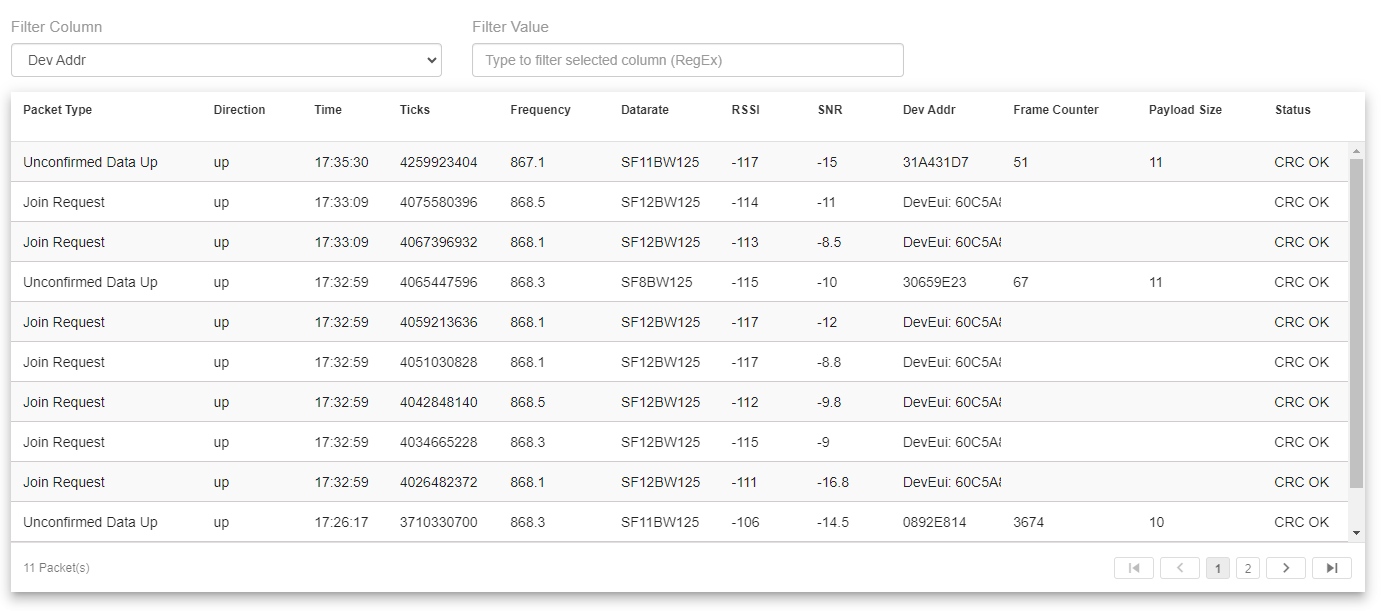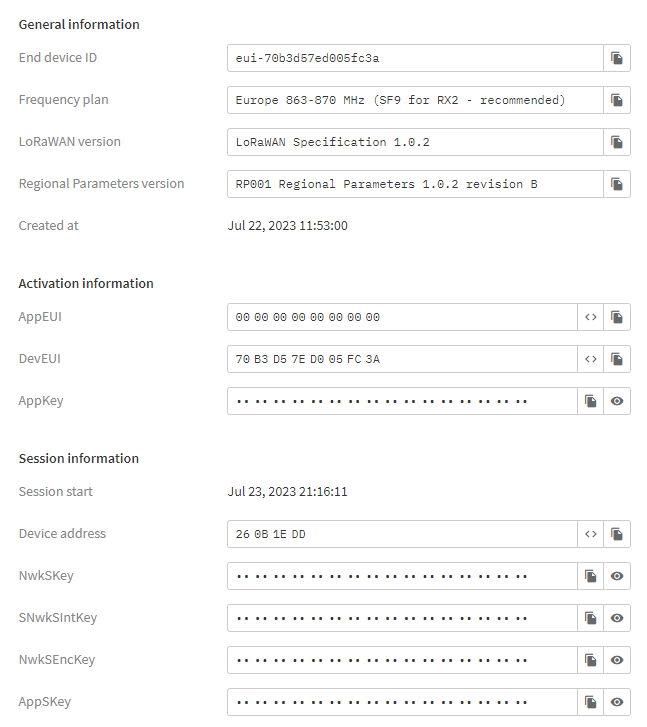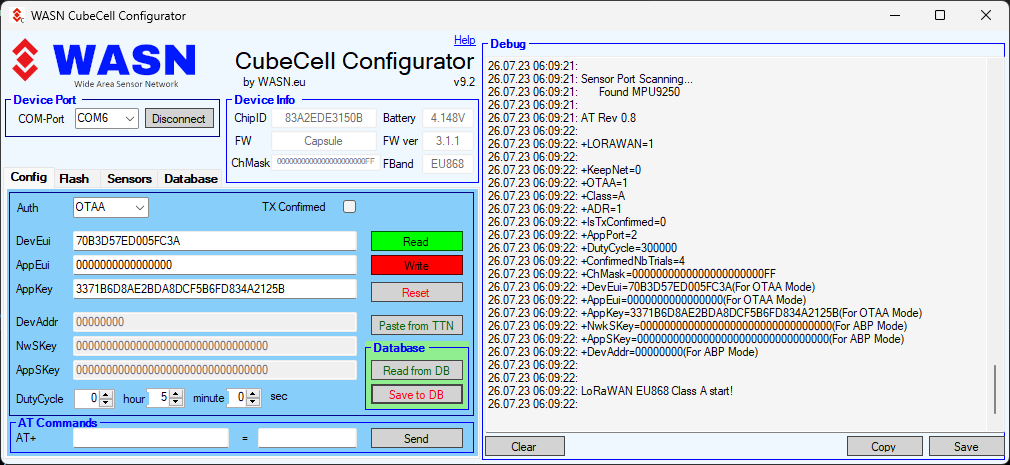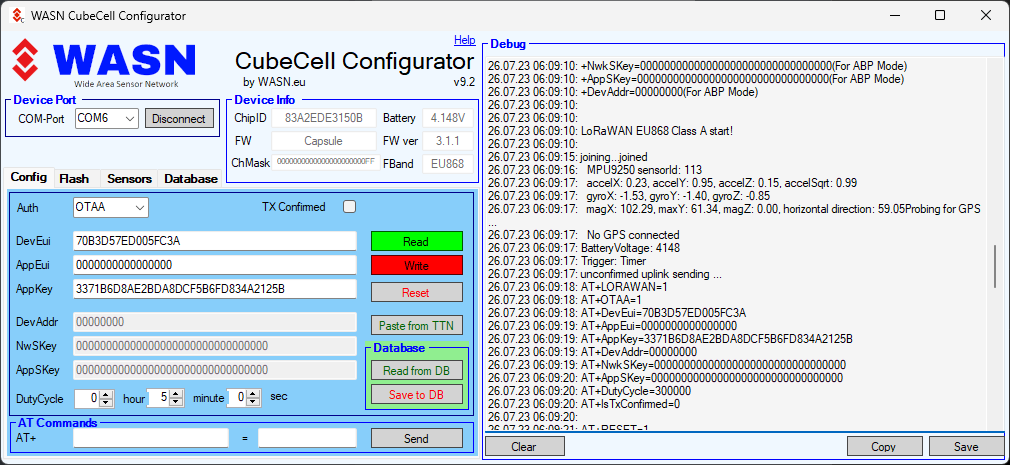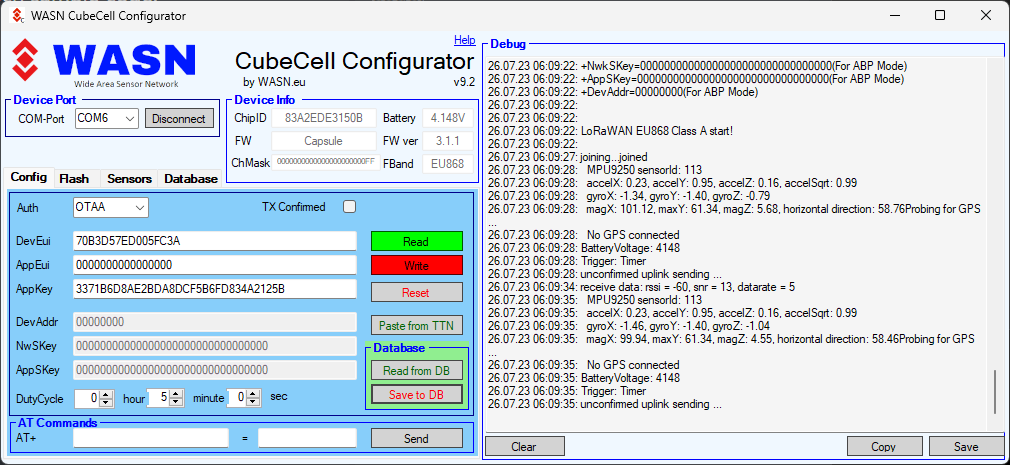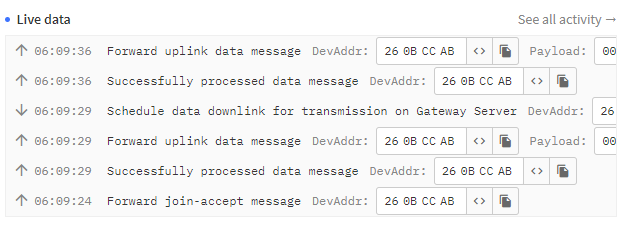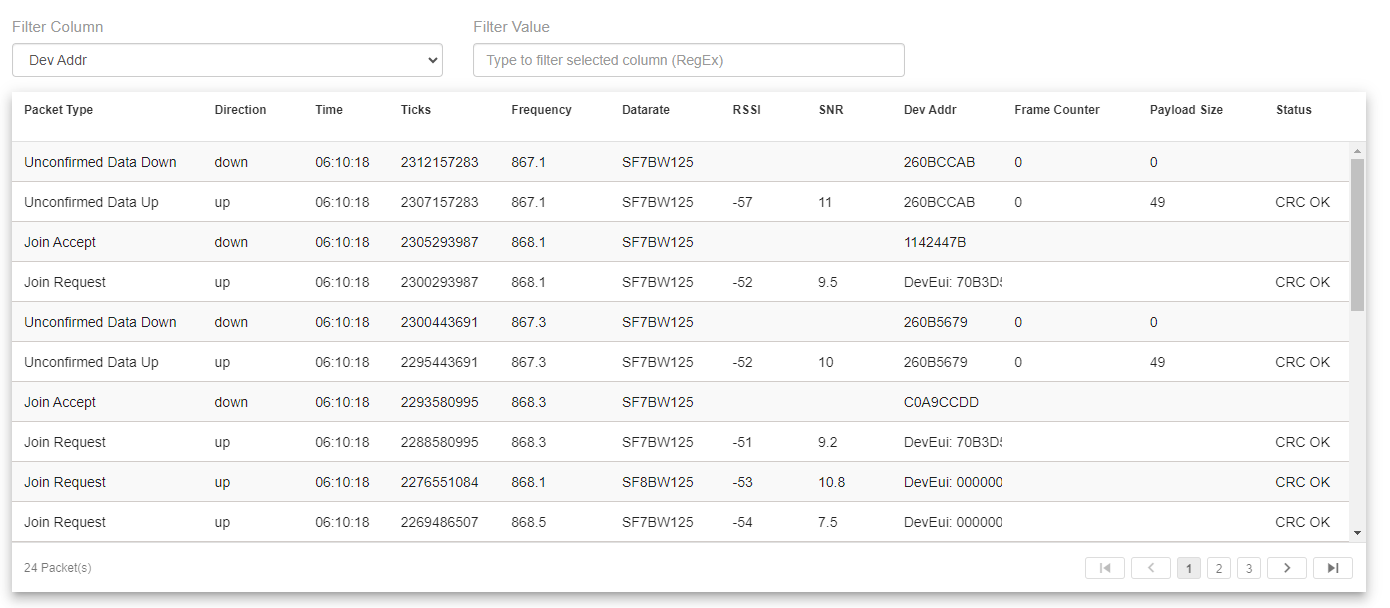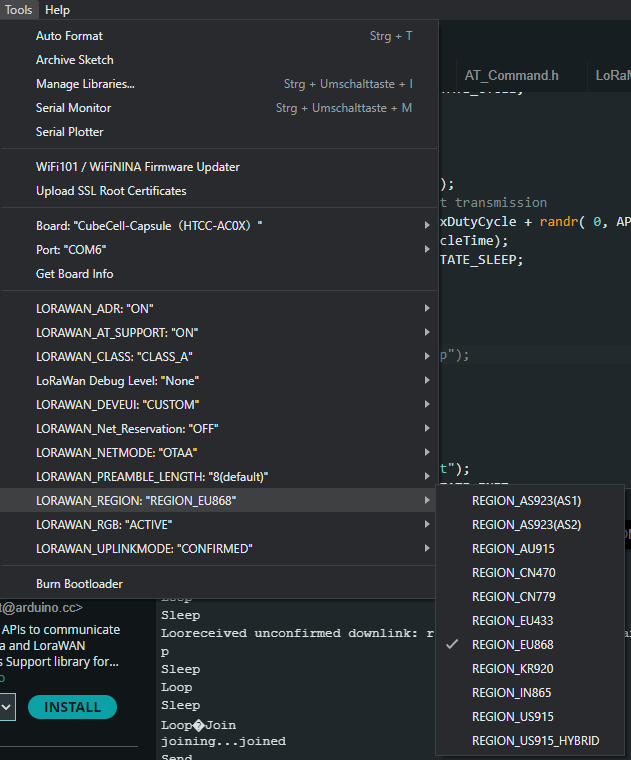My CubeCell Capsule Solar not joining to TTN with code from github repo (LoRaWan_MPU9250).
The same settings with WASN CubeCell Configurator can join to TTN.
The gateway is in the same room.
Copyright @ 2019 Heltec Automation.All rights reserved.
Setup
enableAt
Setup end
Loop
Init
getDevParam
printDevParam
AT Rev 1.3
+AutoLPM=1
+LORAWAN=1
+KeepNet=0
+OTAA=1
+Class=A
+ADR=1
+IsTxConfirmed=0
+AppPort=2
+DutyCycle=300000
+ConfirmedNbTrials=4
+ChMask=0000000000000000000000FF
+DevEui=70B3D57ED005FC3A(For OTAA Mode)
+AppEui=0000000000000000(For OTAA Mode)
+AppKey=3371B6D8AE2BDA8DCF5B6FD834A2125B(For OTAA Mode)
+NwkSKey=00000000000000000000000000000000(For ABP Mode)
+AppSKey=00000000000000000000000000000000(For ABP Mode)
+DevAddr=00000000(For ABP Mode)
LoRaWAN.init
LoRaWAN EU868 Class A start!
Loop
Join
joining…
#include "LoRaWan_APP.h"
#include "Arduino.h"
#include <Wire.h>
#include <MPU9250.h>
/*
* set LoraWan_RGB to Active,the RGB active in loraWan
* RGB red means sending;
* RGB purple means joined done;
* RGB blue means RxWindow1;
* RGB yellow means RxWindow2;
* RGB green means received done;
*/
/* OTAA para*/
// DevEUI 70B3D57ED005FC3A
// appKey 3371B6D8AE2BDA8DCF5B6FD834A2125B
// 0x70, 0xB3, 0xD5, 0x7E, 0xD0, 0x05, 0xFC, 0x3A
// 0x3A, 0xFC, 0x05, 0xD0, 0x7E, 0xD5, 0xB3, 0x70
uint8_t devEui[] = { 0x70, 0xB3, 0xD5, 0x7E, 0xD0, 0x05, 0xFC, 0x3A };
//uint8_t devEui[] = { 0x3A, 0xFC, 0x05, 0xD0, 0x7E, 0xD5, 0xB3, 0x70 };
uint8_t appEui[] = { 0x00, 0x00, 0x00, 0x00, 0x00, 0x00, 0x00, 0x00 };
//0x33, 0x71, 0xB6, 0xD8, 0xAE, 0x2B, 0xDA, 0x8D, 0xCF, 0x5B, 0x6F, 0xD8, 0x34, 0xA2, 0x12, 0x5B
uint8_t appKey[] = { 0x33, 0x71, 0xB6, 0xD8, 0xAE, 0x2B, 0xDA, 0x8D, 0xCF, 0x5B, 0x6F, 0xD8, 0x34, 0xA2, 0x12, 0x5B };
/* ABP para*/
uint8_t nwkSKey[] = { 0x00, 0x00, 0x00, 0x00, 0x00, 0x00, 0x00, 0x00, 0x00, 0x00, 0x00, 0x00, 0x00, 0x00, 0x00, 0x00 };
uint8_t appSKey[] = { 0x00, 0x00, 0x00, 0x00, 0x00, 0x00, 0x00, 0x00, 0x00, 0x00, 0x00, 0x00, 0x00, 0x00, 0x00, 0x00 };
uint32_t devAddr = ( uint32_t )0x00000000;
/*
uint8_t nwkSKey[] = { 0x15, 0xb1, 0xd0, 0xef, 0xa4, 0x63, 0xdf, 0xbe, 0x3d, 0x11, 0x18, 0x1e, 0x1e, 0xc7, 0xda,0x85 };
uint8_t appSKey[] = { 0xd7, 0x2c, 0x78, 0x75, 0x8c, 0xdc, 0xca, 0xbf, 0x55, 0xee, 0x4a, 0x77, 0x8d, 0x16, 0xef,0x67 };
uint32_t devAddr = ( uint32_t )0x007e6ae1;
*/
/*LoraWan channelsmask, default channels 0-7*/
uint16_t userChannelsMask[6]={ 0x00FF,0x0000,0x0000,0x0000,0x0000,0x0000 };
//uint16_t userChannelsMask[6]={ 0xFF00,0x0000,0x0000,0x0000,0x0000,0x0000 };
/*LoraWan region, select in arduino IDE tools*/
LoRaMacRegion_t loraWanRegion = LORAMAC_REGION_EU868;
/*LoraWan Class, Class A and Class C are supported*/
DeviceClass_t loraWanClass = CLASS_A;
/*the application data transmission duty cycle. value in [ms].*/
uint32_t appTxDutyCycle = 300000;
/*OTAA or ABP*/
bool overTheAirActivation = true;
/*ADR enable*/
bool loraWanAdr = true;
/* set LORAWAN_Net_Reserve ON, the node could save the network info to flash, when node reset not need to join again */
bool keepNet = false;
/* Indicates if the node is sending confirmed or unconfirmed messages */
bool isTxConfirmed = false;
/* Application port */
uint8_t appPort = 2;
/*!
* Number of trials to transmit the frame, if the LoRaMAC layer did not
* receive an acknowledgment. The MAC performs a datarate adaptation,
* according to the LoRaWAN Specification V1.0.2, chapter 18.4, according
* to the following table:
*
* Transmission nb | Data Rate
* ----------------|-----------
* 1 (first) | DR
* 2 | DR
* 3 | max(DR-1,0)
* 4 | max(DR-1,0)
* 5 | max(DR-2,0)
* 6 | max(DR-2,0)
* 7 | max(DR-3,0)
* 8 | max(DR-3,0)
*
* Note, that if NbTrials is set to 1 or 2, the MAC will not decrease
* the datarate, in case the LoRaMAC layer did not receive an acknowledgment
*/
uint8_t confirmedNbTrials = 4;
/* Prepares the payload of the frame */
MPU9250 mySensor;
static void prepareTxFrame( uint8_t port )
{
/*appData size is LORAWAN_APP_DATA_MAX_SIZE which is defined in "commissioning.h".
*appDataSize max value is LORAWAN_APP_DATA_MAX_SIZE.
*if enabled AT, don't modify LORAWAN_APP_DATA_MAX_SIZE, it may cause system hanging or failure.
*if disabled AT, LORAWAN_APP_DATA_MAX_SIZE can be modified, the max value is reference to lorawan region and SF.
*for example, if use REGION_CN470,
*the max value for different DR can be found in MaxPayloadOfDatarateCN470 refer to DataratesCN470 and BandwidthsCN470 in "RegionCN470.h".
*/
float aX, aY, aZ, aSqrt, gX, gY, gZ, mDirection, mX, mY, mZ;
pinMode(Vext, OUTPUT);
digitalWrite(Vext, LOW);
Wire.begin();
mySensor.setWire(&Wire);
mySensor.beginAccel();
mySensor.beginGyro();
mySensor.beginMag();
// You can set your own offset for mag values
// mySensor.magXOffset = -50;
// mySensor.magYOffset = -55;
// mySensor.magZOffset = -10;
mySensor.accelUpdate();
aX = mySensor.accelX();
aY = mySensor.accelY();
aZ = mySensor.accelZ();
aSqrt = mySensor.accelSqrt();
Serial.print("aX:");
Serial.println(aX);
Serial.print("aY:");
Serial.println(aY);
Serial.print("aZ:");
Serial.println(aZ);
Serial.print("aSqrt:");
Serial.println(aSqrt);
mySensor.gyroUpdate();
gX = mySensor.gyroX();
gY = mySensor.gyroY();
gZ = mySensor.gyroZ();
Serial.print("gX:");
Serial.println(gX);
Serial.print("gY:");
Serial.println(gY);
Serial.print("gZ:");
Serial.println(gZ);
mySensor.magUpdate();
mX = mySensor.magX();
mY = mySensor.magY();
mZ = mySensor.magZ();
mDirection = mySensor.magHorizDirection();
Serial.print("mX:");
Serial.println(mX);
Serial.print("mY:");
Serial.println(mY);
Serial.print("mZ:");
Serial.println(mZ);
Serial.print("mDirection:");
Serial.println(mDirection);
Wire.end();
digitalWrite(Vext, HIGH);
uint16_t batteryVoltage = getBatteryVoltage();
unsigned char *puc;
puc = (unsigned char *)(&aX);
appDataSize = 46;
appData[0] = puc[0];
appData[1] = puc[1];
appData[2] = puc[2];
appData[3] = puc[3];
puc = (unsigned char *)(&aY);
appData[4] = puc[0];
appData[5] = puc[1];
appData[6] = puc[2];
appData[7] = puc[3];
puc = (unsigned char *)(&aZ);
appData[8] = puc[0];
appData[9] = puc[1];
appData[10] = puc[2];
appData[11] = puc[3];
puc = (unsigned char *)(&gX);
appData[12] = puc[0];
appData[13] = puc[1];
appData[14] = puc[2];
appData[15] = puc[3];
puc = (unsigned char *)(&gY);
appData[16] = puc[0];
appData[17] = puc[1];
appData[18] = puc[2];
appData[19] = puc[3];
puc = (unsigned char *)(&gZ);
appData[20] = puc[0];
appData[21] = puc[1];
appData[22] = puc[2];
appData[23] = puc[3];
puc = (unsigned char *)(&mX);
appData[24] = puc[0];
appData[25] = puc[1];
appData[26] = puc[2];
appData[27] = puc[3];
puc = (unsigned char *)(&mY);
appData[28] = puc[0];
appData[29] = puc[1];
appData[30] = puc[2];
appData[31] = puc[3];
puc = (unsigned char *)(&mZ);
appData[32] = puc[0];
appData[33] = puc[1];
appData[34] = puc[2];
appData[35] = puc[3];
puc = (unsigned char *)(&aSqrt);
appData[36] = puc[0];
appData[37] = puc[1];
appData[38] = puc[2];
appData[39] = puc[3];
puc = (unsigned char *)(&mDirection);
appData[40] = puc[0];
appData[41] = puc[1];
appData[42] = puc[2];
appData[43] = puc[3];
appData[44] = (uint8_t)(batteryVoltage>>8);
appData[45] = (uint8_t)batteryVoltage;
Serial.print("BatteryVoltage:");
Serial.println(batteryVoltage);
}
void setup() {
Serial.begin(115200);
Serial.println("Setup");
#if(AT_SUPPORT)
Serial.println("enableAt");
enableAt();
#endif
deviceState = DEVICE_STATE_INIT;
LoRaWAN.ifskipjoin();
Serial.println("Setup end");
}
void loop()
{
Serial.println("Loop");
switch( deviceState )
{
case DEVICE_STATE_INIT:
{
Serial.println("Init");
#if(LORAWAN_DEVEUI_AUTO)
Serial.println("generateDeveuiByChipID");
LoRaWAN.generateDeveuiByChipID();
#endif
#if(AT_SUPPORT)
Serial.println("getDevParam");
getDevParam();
#endif
Serial.println("printDevParam");
printDevParam();
Serial.println("LoRaWAN.init");
LoRaWAN.init(loraWanClass, loraWanRegion);
deviceState = DEVICE_STATE_JOIN;
break;
}
case DEVICE_STATE_JOIN:
{
Serial.println("Join");
LoRaWAN.join();
break;
}
case DEVICE_STATE_SEND:
{
Serial.println("Send");
prepareTxFrame( appPort );
LoRaWAN.send();
deviceState = DEVICE_STATE_CYCLE;
break;
}
case DEVICE_STATE_CYCLE:
{
Serial.println("Cycle");
// Schedule next packet transmission
txDutyCycleTime = appTxDutyCycle + randr( 0, APP_TX_DUTYCYCLE_RND );
LoRaWAN.cycle(txDutyCycleTime);
deviceState = DEVICE_STATE_SLEEP;
break;
}
case DEVICE_STATE_SLEEP:
{
Serial.println("Sleep");
LoRaWAN.sleep();
break;
}
default:
{
Serial.println("Default");
deviceState = DEVICE_STATE_INIT;
break;
}
}
}
